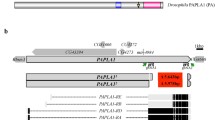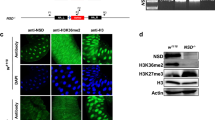Abstract
Hereditary spastic paraplegia (HSP) is a neurodegeneration disease, one of the reasons is caused by autosomal recessive missense mutation of the karyogene that encodes phenylalanyl-tRNA synthetase 2, mitochondrial (FARS2). However, the molecular mechanism underlying FARS2-mediated HSP progression is unknown. Mitochondrial phenylalanyl-tRNA synthetase gene (PheRS-m) is the Drosophila melanogaster homolog gene of human FARS2. This study constructed a Drosophila HSP missense mutation model and a PheRS-m knockout model. Some of the mutant fly phenotypes included developmental delay, shortened lifespan, wing-structure abnormalities and decreased mobility. RNA-sequencing results revealed a relationship between abnormal phenotypes and the hedgehog (Hh) pathway. A qRT-PCR assay was used to determine the key genes (ptc, hib, and slmb) of the Hh pathway that exhibited increased expression during different developmental stages. We demonstrated that Hh signaling transduction is negatively regulated during the developmental stages of PheRS-m mutants but positively regulated during adulthood. By inducing the agonist and inhibitor of Hh pathway in PheRS-m larvae, the developmental delay in mutants can be partly salvaged or postponed. Collectively, our findings indicate that Hh signaling negatively regulates the development of PheRS-m mutants, subsequently leading to developmental delay.






Similar content being viewed by others
Availability of data and materials
All the data will be available upon request to the corresponding author.
References
Faber I, Pereira ER, Martinez ARM, França M Jr, Teive HAG. Hereditary spastic paraplegia from 1880 to 2017: an historical review. Arq Neuropsiquiatr. 2017;75:813–8.
Maruyama T, Baba T, Maemoto Y, Hara-Miyauchi C, Hasegawa-Ogawa M, Okano HJ, Enda Y, Matsumoto K, Arimitsu N, Nakao K, Hamamoto H, Sekimizu K, Ohto-Nakanishi T, Nakanishi H, Tokuyama T, Yanagi S, Tagaya M, Tani K. Loss of DDHD2, whose mutation causes spastic paraplegia, promotes reactive oxygen species generation and apoptosis. Cell Death Dis. 2018;9:797.
Blackstone C. Hereditary spastic paraplegia. Handb Clin Neurol. 2018;148:633–52.
Cui F, Sun L, Qiao J, Li J, Li M, Chen S, Sun B, Huang X. Genetic mutation analysis of hereditary spastic paraplegia: A retrospective study. Medicine (Baltimore). 2020;99:e20193.
Meyyazhagan A, Kuchi Bhotla H, Pappuswamy M, Orlacchio A. The puzzle of hereditary spastic paraplegia: from epidemiology to treatment. Int J Mol Sci. 2022;23:7665.
Yang Y, Liu W, Fang Z, Shi J, Che F, He C, Yao L, Wang E, Wu Y. A newly identified missense mutation in FARS2 causes autosomal-recessive spastic paraplegia. Hum Mutat. 2016;37:165–9.
Hotait M, Nasreddine W, El-Khoury R, Dirani M, Nawfal O, Beydoun A. FARS2 mutations: more than two phenotypes? a case report. Front Genet. 2020;11:787.
Walker MA, Mohler KP, Hopkins KW, Oakley DH, Sweetser DA, Ibba M, Frosch MP, Thibert RL. Novel compound heterozygous mutations expand the recognized phenotypes of FARS2-linked disease. J Child Neurol. 2016;31:1127–37.
Chen X, Liu F, Li B, Wang Y, Yuan L, Yin A, Chen Q, Hu W, Yao Y, Zhang M, Wu Y, Chen K. Neuropathy-associated Fars2 deficiency affects neuronal development and potentiates neuronal apoptosis by impairing mitochondrial function. Cell Biosci. 2022;12:103.
Sansone CL, Blumenthal EM. Neurodegeneration in drop-dead mutant drosophila melanogaster is associated with the respiratory system but not with Hypoxia. PLoS ONE. 2013;8:e68032.
Hughes SC, Simmonds AJ. Drosophila mRNA localization during later development: past, present, and future. Front Genet. 2019;10:135.
Aryal B, Lee Y. Disease model organism for Parkinson disease: Drosophila melanogaster. BMB Rep. 2019;52:250–8.
Zhou Z, Yao X, Li S, Xiong Y, Dong X, Zhao Y, Jiang J, Zhang Q. Deubiquitination of Ci/Gli by Usp7/HAUSP regulates hedgehog signaling. Dev Cell. 2015;34:58–72.
Ogden SK, Ascano M Jr, Stegman MA, Robbins DJ. Regulation of Hedgehog signaling: a complex story. Biochem Pharmacol. 2004;67:805–14.
Rallis A, Navarro JA, Rass M, Hu A, Birman S, Schneuwly S, Thérond PP. Hedgehog signaling modulates glial proteostasis and lifespan. Cell Rep. 2020;30:2627-2643.e2625.
Lee RT, Zhao Z, Ingham PW. Hedgehog signalling. Development. 2016;143:367–72.
Chen Y, Jiang J. Decoding the phosphorylation code in Hedgehog signal transduction. Cell Res. 2013;23:186–200.
Aza-Blanc P, Kornberg TB. Ci: a complex transducer of the hedgehog signal. Trends Genet. 1999;15:458–62.
Bassett AR, Tibbit C, Ponting CP, Liu JL. Highly efficient targeted mutagenesis of Drosophila with the CRISPR/Cas9 system. Cell Rep. 2013;4:220–8.
Gratz SJ, Ukken FP, Rubinstein CD, Thiede G, Donohue LK, Cummings AM, O’Connor-Giles KM. Highly specific and efficient CRISPR/Cas9-catalyzed homology-directed repair in Drosophila. Genetics. 2014;196:961–71.
Wagner GP, Kin K, Lynch VJ. Measurement of mRNA abundance using RNA-seq data: RPKM measure is inconsistent among samples. Theory Biosci. 2012;131:281–5.
Gargano JW, Martin I, Bhandari P, Grotewiel MS. Rapid iterative negative geotaxis (RING): a new method for assessing age-related locomotor decline in Drosophila. Exp Gerontol. 2005;40:386–95.
Clark IE, Dodson MW, Jiang C, Cao JH, Huh JR, Seol JH, Yoo SJ, Hay BA, Guo M. Drosophila pink1 is required for mitochondrial function and interacts genetically with parkin. Nature. 2006;441:1162–6.
Chen JK, Taipale J, Young KE, Maiti T, Beachy PA. Small molecule modulation of smoothened activity. Proc Natl Acad Sci U S A. 2002;99:14071–6.
Cancer M, Hutter S, Holmberg KO, Rosen G, Sundstrom A, Tailor J, Bergstrom T, Garancher A, Essand M, Wechsler-Reya RJ, Falk A, Weishaupt H, Swartling FJ. Humanized stem cell models of pediatric medulloblastoma reveal an Oct4/mTOR axis that promotes malignancy. Cell Stem Cell. 2019;25:855-870 e811.
Biehs B, Kechris K, Liu S, Kornberg TB. Hedgehog targets in the Drosophila embryo and the mechanisms that generate tissue-specific outputs of Hedgehog signaling. Development. 2010;137:3887–98.
Briscoe J, Therond PP. The mechanisms of Hedgehog signalling and its roles in development and disease. Nat Rev Mol Cell Biol. 2013;14:416–29.
Tabata T, Kornberg TB. Hedgehog is a signaling protein with a key role in patterning Drosophila imaginal discs. Cell. 1994;76:89–102.
Mitchell NC, Lin JI, Zaytseva O, Cranna N, Lee A, Quinn LM. The Ecdysone receptor constrains wingless expression to pattern cell cycle across the Drosophila wing margin in a Cyclin B-dependent manner. BMC Dev Biol. 2013;13:28.
Baker NE. Patterning signals and proliferation in Drosophila imaginal discs. Curr Opin Genet Dev. 2007;17:287–93.
Cui G, Yuan H, Jiang Z, Zhang J, Sun Z, Zhong G. Natural harmine negatively regulates the developmental signaling network of Drosophila melanogaster (Drosophilidae: Diptera) in vivo. Ecotoxicol Environ Saf. 2020;190:110134.
Lin Z, Li S, Sheng H, Cai M, Ma LY, Hu L, Xu S, Yu LS, Zhang N. Suppression of GLI sensitizes medulloblastoma cells to mitochondria-mediated apoptosis. J Cancer Res Clin Oncol. 2016;142:2469–78.
Yao PJ, Manor U, Petralia RS, Brose RD, Wu RT, Ott C, Wang YX, Charnoff A, Lippincott-Schwartz J, Mattson MP. Sonic hedgehog pathway activation increases mitochondrial abundance and activity in hippocampal neurons. Mol Biol Cell. 2017;28:387–95.
Acknowledgements
We thank Fungene Biotech (http://www.fungene.tech) and Guangzhou Genedenovo Biotechnology Co., Ltd for help.
Funding
This study was supported by the Key Innovative Project in Shaanxi, Grant/Award Number: 2021ZDLSF02-02, 2022KXJ-123; National Natural Science Foundation of China, Grant/Award Number: 81671476, 82271893.
Author information
Authors and Affiliations
Contributions
L. Mo and R. Li contributed to the conceptualization, data curation, data collection, data validation structural analysis, investigation, statistical analysis, visualization, and writing of the original draft. C. He contributed to the methodology, manuscript writing. Q. Chen and C. Xu contributed to data collection and statistical analysis. L. Shen, K. Chen and Y. Wu contributed to the conceptualization, project administration, and writing (editing). All authors contributed to the article and approved the submitted version.
Corresponding authors
Ethics declarations
Conflict of interest
The authors declare that the research was conducted in the absence of any commercial or financial relationships that could be construed as a potential conflict of interest.
Additional information
Publisher's Note
Springer Nature remains neutral with regard to jurisdictional claims in published maps and institutional affiliations.
Supplementary Information
Below is the link to the electronic supplementary material.
Rights and permissions
Springer Nature or its licensor holds exclusive rights to this article under a publishing agreement with the author(s) or other rightsholder(s); author self-archiving of the accepted manuscript version of this article is solely governed by the terms of such publishing agreement and applicable law.
About this article
Cite this article
Mo, L., Li, R., He, C. et al. Hedgehog pathway is negatively regulated during the development of Drosophila melanogaster PheRS-m (Drosophila homologs gene of human FARS2) mutants. Human Cell 36, 121–131 (2023). https://doi.org/10.1007/s13577-022-00796-0
Received:
Accepted:
Published:
Issue Date:
DOI: https://doi.org/10.1007/s13577-022-00796-0




